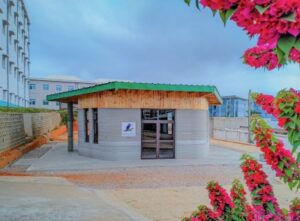Nearly 260 million young people around the world lack access to education. Maggie Grout, 23, is working to change that. At just 15, Grout had the vision to increase access to education infrastructure by building 3D-printed schools.
She launched the innovative nonprofit Thinking Huts in 2015, and last year, the organization completed one of the world’s first 3D-printed schools in Madagascar. Now, Grout and her team are working on an even more ambitious initiative: an entire campus.
The Honeycomb Campus will be built on the west coast of Madagascar in the shape of a beehive, symbolizing how Thinking Huts brings people together in pursuit of a common goal. Comprising several connected huts and including plumbing, solar power, wifi, and a water well, it will serve three nearby villages — enabling hundreds of students ages 4-16 to attend school.
The 3D-printing process takes far less time than traditional building methods — a matter of mere days — and uses 50% of the concrete. It may also result in lower CO2 emissions by reducing construction waste, per the nonprofit.
“We are currently trying to transport our printer to remain permanently in Madagascar and optimistically aim to print in the new year,” Grout told Nice News of the project. “Once this is completed, we will prepare for an expansion to the campus based on the community’s needs and speed of growth.”
She added: “Looking ahead, we are considering where to scale next long term and will continue our work within Madagascar, which is only made possible by incredible humans like you!”
The organization considered seven countries when deciding where to build its first 3D-printed school, ultimately choosing Madagascar due to its “real need for schools, stable political outlook in an emerging economy, the opportunity for growth, as well as renewable energy potential,” the website states. Another large factor in that decision was the ability to form meaningful local partnerships, as Thinking Huts is committed to empowering its schools’ surrounding communities and creating jobs.
“Education has ripple effects that impact the student, family, community, economy, and beyond. Not just one, but thousands, if not millions of lives,” Grout said in a statement. “Change does not happen overnight, but it impacts multiple generations. When we incorporate technology thoughtfully, the impact can be scaled with the necessary resources.”
And Thinking Huts is helping to inspire and educate in other ways as well, including through a global photo competition called Capturing Humankind, which is open to all ages.
“The broad theme of humankind is to explore and understand what it means to be human, including our strengths, weaknesses, ability to overcome challenges, and the beauty we possess,” the website explains.
“Photographers are encouraged to capture different aspects of human nature, such as personal stories, struggles we face together, both small and big acts of kindness, and the unity we find in our diversity,” it continues.
SF Source Nice News Sep 2023

 Rebekah Brandes –
Rebekah Brandes –